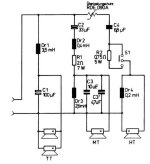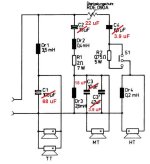I've modified my beloved commercial speakers; Braun LS200. In fact, these speakers sound decent, at least to me, and they received many positive reviews. But that was about 40 years ago--in the 80s era. If compared to nowadays speakers, they aren't perfect speakers though. They have a lot of cabinet talk. I solved this problem by try reducing mid-bass output from the dual 10" woofers. It was achieved by reducing Q of the woofers' low-pass to allow amplifier to provide more control to the woofers. Then, a slight EQ on the upper high region was added, by means of increasing Q of the low-pass of the 2" dome midrange to gain a couple of SPL there. Finally, the mid-high region was too strong as a result of midrange's mod. Hence, I decrease some duty of tweeters by raising their cut-off frequency a bit. All of these were done with extensively use of simulations on VituixCAD.
For technical detail:
Woofer - the 100uF capacitor was replaced with a lower capacitance of 68uF to lowering mid-bass output and gained lower Q at the same time.
Midrange - the 33uF capacitor on the high-pass section was replaced with lower capacitance of 22uF to flatten frequency response curve that was risen due to the woofers' midrange reproduction. And The 14.7uF capacitor on the low-pass section was replaced with 22uF too to produce more mid-high region for personal preference.
Tweeter - there was an overlap at mid-high region as a result of midrange's mod, the solution was to reduce some duty of tweeter's operating range. Consequently, the 6.8uF capacitor was replaced with 3.9uF.
I need some opinion, analyzing or even criticizing on my modification such as pros and cons, should do and should not do suggestions, although I am already satisfied with it.
For technical detail:
Woofer - the 100uF capacitor was replaced with a lower capacitance of 68uF to lowering mid-bass output and gained lower Q at the same time.
Midrange - the 33uF capacitor on the high-pass section was replaced with lower capacitance of 22uF to flatten frequency response curve that was risen due to the woofers' midrange reproduction. And The 14.7uF capacitor on the low-pass section was replaced with 22uF too to produce more mid-high region for personal preference.
Tweeter - there was an overlap at mid-high region as a result of midrange's mod, the solution was to reduce some duty of tweeter's operating range. Consequently, the 6.8uF capacitor was replaced with 3.9uF.
I need some opinion, analyzing or even criticizing on my modification such as pros and cons, should do and should not do suggestions, although I am already satisfied with it.
Attachments
Show us your measurements and vituixcad simulations if you want comments.Anyone?
But anyhow, if you are happy that's all that matters!
Are you doing this all by theory and ear? You said "cabinet talk"; Did you try bracing the cabinet? Did you try replacing all electrolytic caps with new original value caps first to ensure the crossover was performing as intended?
You are probably not getting much feedback because without measurements most people probably feel further commentary would be fruitless.
You are probably not getting much feedback because without measurements most people probably feel further commentary would be fruitless.
I went back to VituixCAD again after recognized one thing that I should have performed the "deep null" check for the best phase response, without looking at phase response graph. I did it by reverse polarity of woofer in VituixCAD and varied capacitance of the woofer's low-pass filter. I got the deepest null on frequency response curve when C was 47uF. I suddenly replaced the 68uF on the PCB again with the 47uF capacitor. I got better result in listening test. The cabinet talk, or actually the excessive mid-bass, is now completely eliminated. The speakers now sound right to my ears. I also replaced the 0.75 Ohms resistor on tweeter's circuit with a 10uF capacitor so I could switch capacitor for tweeter's high-pass filter between original 6.8uF and 3.9uF (6.8uF in series with 10uF). I'm happy with my new crossovers now.
With actual measured curves? Or with idealized flat curves that VituixCAD provides? If it's the latter, then we can't talk about it because that's not the actual response of your speakers.I went back to VituixCAD...

